There is a sense of anticipation that awaits the unveiling of SNIA’s Data Storage Innovation (DSI) conference agenda. DSI is unique in its focus as a conference for those that use information technology. Each year, the agenda expands as hundreds of submissions are received, reviewed, and considered for addition to the schedule.
2016 brings the most extensive topic agenda to date for DSI, set for June 13-15, 2016 and newly located in San Mateo for the convenience of those flying in to SFO, San Francisco and East 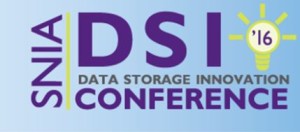 Bay attendees, as well as those in Silicon Valley. DSI’s agenda committee, comprised of SNIA volunteer leaders from leading IT organizations, are attuned to the changing needs of an IT audience confronting next generation data centers, enterprise computing’s shift to the cloud, and the drive to data analytics for business decisions. The agenda’s 20 themed topics include hyperconvergence, cloud, data protection, big data, security, cloud, persistent memory, software defined storage, containers, and distributed storage. And the 75 sessions within these topics are a mix of industry leadership, SNIA’s vendor neutral tutorial education, and sponsored sessions.
Bay attendees, as well as those in Silicon Valley. DSI’s agenda committee, comprised of SNIA volunteer leaders from leading IT organizations, are attuned to the changing needs of an IT audience confronting next generation data centers, enterprise computing’s shift to the cloud, and the drive to data analytics for business decisions. The agenda’s 20 themed topics include hyperconvergence, cloud, data protection, big data, security, cloud, persistent memory, software defined storage, containers, and distributed storage. And the 75 sessions within these topics are a mix of industry leadership, SNIA’s vendor neutral tutorial education, and sponsored sessions.
The DSI General Sessions emcee, reprising her highly received 2015 role, will be Camberley Bates, Managing Director and Senior Analyst, the Evaluator Group, who will also co-host a keynote on enterprise storage architectures. Additional keynotes at this time include “Storage Architectures for Next Generation Cognitive Analytics” presented by Huawei, and an IBM industry perspective on Enterprise Computing and Data Storage.
New also for 2016 will be a session on results from a new survey co-sponsored by SNIA and the Evaluator group on enterprise deployment of hyperconverged solutions.
We invite you to peruse the DSI Conference agenda online, and make your plans to attend and participate in a conference rich in one-on-one discussions, lots of opportunities for “hallway networking”, and up-to-date technical knowledge presented without vendor bias. Register here. If you want to understand more about how DSI works, a new video available on the DSI conference website walks you through the highlights of the conference, with perspectives from Wayne Adams, DSI Conference agenda chair, on how the sessions provide a roadmap of where the industry is going. Camberley Bates also offers her feedback on why the conference is important in the ability to communicate with peers and learn firsthand their approaches to solving today’s enterprise issues.
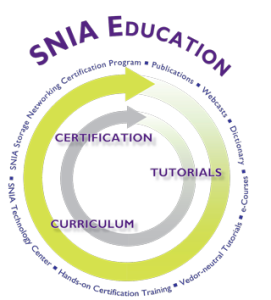
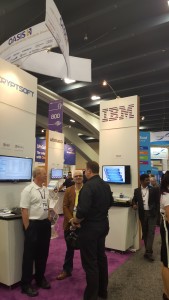 , and adoption of open standards for the global information society. The OASIS KMIP TC works to define a single, comprehensive protocol for communication between encryption systems and a broad range of new and legacy enterprise applications, including email, databases, and storage devices. The resulting Protocol, its profiles, and test cases are defined by the OASIS KMIP Technical Committee. By removing redundant, incompatible key management processes, KMIP provides better data security while at the same time reducing expenditures on multiple products.
, and adoption of open standards for the global information society. The OASIS KMIP TC works to define a single, comprehensive protocol for communication between encryption systems and a broad range of new and legacy enterprise applications, including email, databases, and storage devices. The resulting Protocol, its profiles, and test cases are defined by the OASIS KMIP Technical Committee. By removing redundant, incompatible key management processes, KMIP provides better data security while at the same time reducing expenditures on multiple products.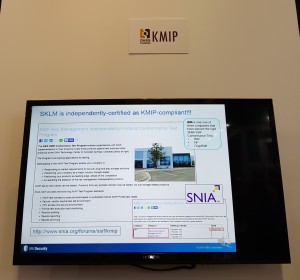 SNIA provides a KMIP Conformance Test Program that enables organizations with KMIP implementations in their products to test those products against test tools and other products at the SNIA Technology Center in Colorado Springs, Colorado. According to SNIA’s KMIP Test Program Manager David Thiel, the KMIP Test Program provides independent verification from a trusted third party that a given KMIP implementation conforms to the KMIP standard. Verification gives confidence to both vendors and end users of KMIP solutions that a product will interoperate with other similarly tested KMIP products. KMIP support has become a prerequisite requirement for organizations looking to acquire storage and security key management solutions.
SNIA provides a KMIP Conformance Test Program that enables organizations with KMIP implementations in their products to test those products against test tools and other products at the SNIA Technology Center in Colorado Springs, Colorado. According to SNIA’s KMIP Test Program Manager David Thiel, the KMIP Test Program provides independent verification from a trusted third party that a given KMIP implementation conforms to the KMIP standard. Verification gives confidence to both vendors and end users of KMIP solutions that a product will interoperate with other similarly tested KMIP products. KMIP support has become a prerequisite requirement for organizations looking to acquire storage and security key management solutions.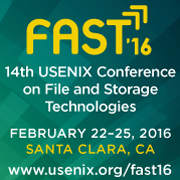
 SNIA membership, you are invited to attend a very special keynote presented on January 19 at 8:45 am on IT Trends that Matter in 2016, presented by Mr. Hubert Yoshida, CTO of Hitachi Data Systems. Mr. Yoshida will comment on how innovative technology companies that quickly capitalize on business opportunities and satisfy the demands of today’s empowered consumer have caused a wave of disruption. In 2016, businesses will turn to IT for solutions that will keep them competitive. Chief Information Officers will invest in faster delivery of applications and analytics, and transform IT by leveraging the third platform, social, mobile, analytics, and cloud. Mr. Yoshida will advise on how to avoid distractions and remain focused on the IT trends that matter in 2016.
SNIA membership, you are invited to attend a very special keynote presented on January 19 at 8:45 am on IT Trends that Matter in 2016, presented by Mr. Hubert Yoshida, CTO of Hitachi Data Systems. Mr. Yoshida will comment on how innovative technology companies that quickly capitalize on business opportunities and satisfy the demands of today’s empowered consumer have caused a wave of disruption. In 2016, businesses will turn to IT for solutions that will keep them competitive. Chief Information Officers will invest in faster delivery of applications and analytics, and transform IT by leveraging the third platform, social, mobile, analytics, and cloud. Mr. Yoshida will advise on how to avoid distractions and remain focused on the IT trends that matter in 2016.